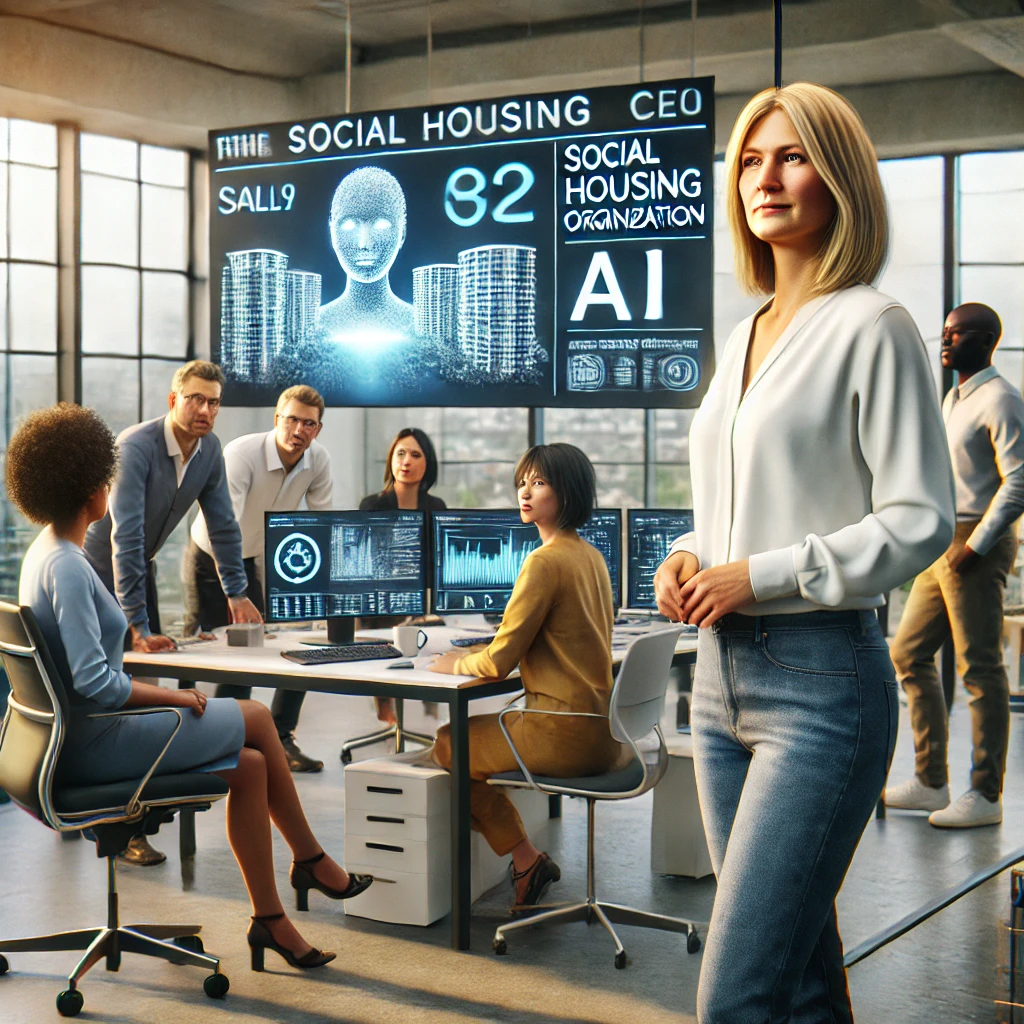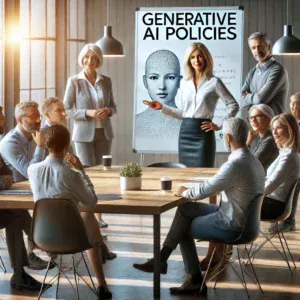Sally, the CEO of a mid-sized housing association, is no stranger to the pressures of modernising her organisation. She’s committed to keeping her community at the forefront of every decision, while also exploring technologies that enhance operational efficiency and improve tenant experiences. One such technology that piqued her interest was Gen AI. But Sally wasn’t interested in hype—she wanted practical solutions that genuinely improved lives. This is the story and steps of how Sally embraced Gen AI and began to modernise her housing association.
Why Gen AI Caught Sally’s Eye
Sally had heard about generative AI’s capabilities in various sectors, but she wasn’t certain about its relevance to social housing. She asked herself: Could this technology truly elevate our mission to serve tenants better? In a discussion with her Chair David, he suggested that she should have a look at a website Demystifying AI for Social Housing Leaders.
Step 1: Assessing AI Readiness
Having visited the site, Sally began by conducting a thorough AI readiness assessment to evaluate how prepared her housing association was to adopt AI. This assessment revealed key gaps in skills and technology, which helped Sally map out the next steps strategically. With a clear understanding of where her organisation stood, Sally felt ready to dive deeper into the possibilities of AI.
Step 2: Exploring Real-World AI Applications
Curiosity led Sally to research how other organisations were using AI effectively. She explored successful case studies from similar sectors, which provided her with real-world insights. Sally discovered how AI was used to streamline tenant services, automate administrative tasks, and make data-driven decisions. Seeing these practical examples helped Sally envision how AI could solve specific challenges in her housing association.
Sally found inspiration in a housing association that used AI to predict maintenance needs, thereby reducing costly emergency repairs. She realised that by using similar AI tools, her team could proactively manage maintenance, ultimately enhancing tenant satisfaction.
Step 3: Developing a Vision and Integration Roadmap

With insights from case studies, Sally needed a clear strategy, so she downloaded the guide titled “ Empowering Social Housing Leaders: AI Vision & Roadmap for Operational Excellence”, that she found on the website. This guide helped her develop her AI adoption plan. This roadmap was crucial in outlining her goals for Gen AI: enhancing tenant engagement, improving operational efficiency, and automating routine administrative tasks.
Sally’s vision was ambitious but practical. She wanted AI to serve as a supportive tool that could elevate her team’s capabilities without compromising the organisation’s core mission. The integration roadmap provided her with a step-by-step approach, ensuring each AI initiative aligned with the long-term goals of her housing association.
Step 4: Conducting a Gap Analysis
Next, Sally conducted a Gap Analysis using the Executive Readiness Checklist. This allowed her to identify the specific resources and skills her team needed to succeed with AI. The checklist made it clear that while her organisation had the data and the will to proceed, they needed more training in AI literacy to make the transition effective.
By understanding these gaps, Sally was able to allocate resources to upskill her staff. She organised workshops and training sessions, empowering her team to use AI tools confidently. This preparation ensured that her organisation was ready not only to adopt AI but to make the most of its capabilities.
Step 5: Building a Business Case for AI
To secure buy-in from her board and stakeholders, Sally needed a strong business case. She used the AI Business Case Guide to articulate the financial and operational benefits of adopting AI. The business case outlined potential cost savings, increased efficiency, and improved tenant satisfaction.
Sally presented her plan to the board, emphasising the long-term benefits. By showcasing data from similar organisations that had successfully implemented AI, she was able to demonstrate the tangible impact it could have. This helped her secure the necessary approval to move forward with her AI initiatives.
Modernising Operations with Gen AI

With a solid plan in place, Sally began integrating Gen AI into her housing association’s daily operations. Here’s how AI started making a real difference.
1. Improving Tenant Communication
Managing tenant inquiries was one of Sally’s team’s most time-consuming tasks. Gen AI provided an efficient solution through AI-powered chatbots. These chatbots offered tenants 24/7 assistance, answering questions about rent, maintenance requests, and general services. This significantly reduced the workload for Sally’s staff and improved tenant satisfaction by providing timely responses.
Moreover, AI helped personalise tenant interactions. By analysing data, the AI system tailored communication to each tenant, making them feel heard and valued. This personal touch improved relationships and trust between tenants and the housing association.
2. Predictive Maintenance for Proactive Solutions
Maintenance had always been a reactive process—waiting until something broke before fixing it. With predictive AI, Sally shifted her team’s approach to proactive maintenance. By analysing historical data, AI tools predicted when maintenance would be needed, allowing Sally’s team to address issues before they became major problems.
This proactive approach reduced downtime, saved money, and ensured tenants lived in well-maintained properties. The result was higher tenant satisfaction and a more efficient use of resources.
3. Automating Routine Administrative Tasks
Sally also saw the potential for AI to handle routine administrative tasks, such as report generation and compliance monitoring. Gen AI tools could quickly summarise lengthy reports and help prepare documents for board meetings. This allowed her staff to focus on more strategic initiatives rather than getting bogged down in paperwork.
Addressing Ethical Considerations and Challenges
As Sally moved forward with AI, she remained cautious about its ethical implications. Transparency and ethics were non-negotiable aspects of her strategy.
Ethical AI Implementation
Sally knew that AI could sometimes reflect biases in the data it was trained on. To mitigate this, she established an AI Ethics Committee to oversee AI use, ensuring that tenant data was handled responsibly and that AI systems were transparent and fair. This proactive approach reassured both her team and the tenants that AI was being used to support their needs ethically.
AI as a Tool to Empower Staff, Not Replace Them
Initially, some staff were concerned about the implications of AI—would it replace their jobs? Sally made it clear that AI was intended to complement their work, not replace it. By automating repetitive tasks, AI freed up her staff to focus on activities that required human empathy and problem-solving skills.
She also invested in staff training, helping them understand how to use AI effectively. This not only alleviated their fears but also empowered them to make better use of their time and skills.
Moving Forward: Sally’s AI Roadmap in Action
With AI initiatives underway, Sally continued to monitor their impact closely. She started small, with chatbots and predictive maintenance, and expanded as her team grew more comfortable with the technology. Regular reviews helped her tweak the AI strategy as needed, ensuring it remained aligned with the organisation’s goals.
Sally’s journey with Gen AI wasn’t just about adopting new technology; it was about transforming her organisation to be more proactive, efficient, and tenant-focused. By keeping ethics at the forefront and ensuring her team felt supported, Sally successfully integrated AI in a way that benefited everyone involved.
Conclusion: Embracing AI for a Modern Future
For leaders like Sally, Gen AI offers an incredible opportunity to enhance how housing associations operate. By taking a strategic approach—starting small, addressing ethical concerns, and ensuring alignment with organisational values—Sally was able to modernise her housing association without losing sight of its mission.
AI isn’t just about technology; it’s about making meaningful improvements in the lives of tenants and empowering staff to do their best work. With the right approach, AI can help housing associations thrive and create a better future for the communities they serve.
Embracing Gen AI; Visit iwp’s Demystifying AI for Social Housing Leaders to explore practical, easy-to-understand resources tailored to help leaders master the AI landscape. Get the insights you need to drive innovation and improve service delivery!





